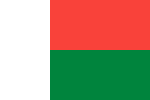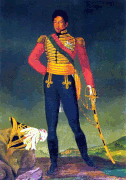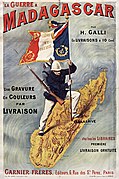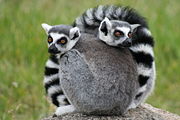The Madagascar Portal
Madagascar, officially the Republic of Madagascar, is an island country comprising the island of Madagascar and numerous smaller peripheral islands. Lying off the southeastern coast of Africa, it is the world's fourth largest island, the second-largest island country and the 46th largest country in the world. Its capital and largest city is Antananarivo. Following the prehistoric breakup of the supercontinent Gondwana, Madagascar split from Africa during the Early Jurassic, around 180 million years ago, and split from the Indian subcontinent around 90 million years ago, allowing native plants and animals to evolve in relative isolation; consequently, it is a biodiversity hotspot and one of the world's 17 megadiverse countries, with over 90% of wildlife being endemic. The island has a subtropical to tropical maritime climate. Madagascar was first settled during or before the mid-first millennium AD by Austronesian peoples, presumably arriving on outrigger canoes from present-day Indonesia. These were joined around the ninth century AD by Bantu migrants crossing the Mozambique Channel from East Africa. Other groups continued to settle on Madagascar over time, each one making lasting contributions to Malagasy cultural life. Consequently, there are 18 or more classified peoples of Madagascar, the most numerous being the Merina of the central highlands. Until the late 18th century, the island of Madagascar was ruled by a fragmented assortment of shifting sociopolitical alliances. Beginning in the early 19th century, most of it was united and ruled as the Kingdom of Madagascar by a series of Merina nobles. The monarchy was ended in 1897 by the annexation by France, from which Madagascar gained independence in 1960. The country has since undergone four major constitutional periods, termed republics, and has been governed as a constitutional democracy since 1992. Following a political crisis and military coup in 2009, Madagascar underwent a protracted transition towards its fourth and current republic, with constitutional governance being restored in January 2014. (Full article...) This is a Featured article, which represents some of the best content on English Wikipedia..
Ambohimanga is a hill and traditional fortified royal settlement (rova) in Madagascar, located approximately 24 kilometers (15 mi) northeast of the capital city of Antananarivo. It is situated in the commune of Ambohimanga Rova. The hill and the rova that stands on top are considered the most significant symbol of the cultural identity of the Merina people and the most important and best-preserved monument of the precolonial Merina Kingdom. The walled historic village includes residences and burial sites of several key monarchs. The site, one of the twelve sacred hills of Imerina, is associated with strong feelings of national identity and has maintained its spiritual and sacred character both in ritual practice and the popular imagination for at least four hundred years. It remains a place of worship to which pilgrims come from Madagascar and elsewhere. (Full article...) Selected article - The Kingdom of Merina, also known as the Kingdom of Madagascar and officially the Kingdom of Imerina (Malagasy: Fanjakan'Imerina; c. 1540–1897), was a pre-colonial state off the coast of Southeast Africa that, by the 18th century, dominated most of what is now Madagascar. It spread outward from Imerina, the Central Highlands region primarily inhabited by the Merina ethnic group with a spiritual capital at Ambohimanga and a political capital 24 km (15 mi) west at Antananarivo, currently the seat of government for the modern state of Madagascar. The Merina kings and queens who ruled over greater Madagascar in the 19th century were the descendants of a long line of hereditary Merina royalty originating with Andriamanelo, who is traditionally credited with founding Imerina in 1540. In 1883, France invaded the Merina Kingdom to establish a protectorate. France invaded again in 1894 and conquered the kingdom, making it a French colony, in what became known as the Franco-Hova Wars. (Full article...) This is a Good article, an article that meets a core set of high editorial standards.
The Mikea are a group of Malagasy-speaking horticulturalists and foragers who are often described as the lowland hunter-gatherers of Madagascar. They inhabit the Mikea Forest, a patch of mixed spiny forest and dry deciduous forest along the coast of southwestern Madagascar. The Mikea are predominantly of Sakalava origin, although the term describes a shared way of life rather than an ethnic group per se, and individuals from a variety of Malagasy ethnic groups are found among the Mikea. The family encampments of the Mikea shift from prime corn planting territory at the edge of the forest in the rainy season to the interior forest rich with tenrecs and other game in the dry season, when the community becomes highly dependent on spongy tubers to meet their daily demand for water. Their lifestyle is interdependent with that of their neighboring Vezo fishermen and the Masikoro farmers and herders, with whom they trade products caught, foraged or cultivated in the forest. Many Mikea also occasionally engage in paid work such as guarding the zebu herds or tending the corn fields of others. The present-day Mikea are not a remnant of an ancient Malagasy hunter-gatherer society, but are instead descendants of individuals who took refuge in the forest beginning in the 1800s to escape military conflict, heavy taxation and other oppressive factors. Their way of life is perceived by villagers and city dwellers alike as ancestral, contributing to a mystique about them that has inspired various myths and legends. They are commonly believed to be the mythical Vazimba, the original inhabitants of the island, although there is no evidence to support this view. They are distinct from the Beosi hunter-gatherers of the highlands. While some 1,500 individuals are known to identify as Mikea, many Malagasy disbelieve that the community continues to exist in the present day. (Full article...) General images -The following are images from various Madagascar-related articles on Wikipedia.
Selected panoramaRice fields near Ambalandingana, Madagascar.
TopicsCategoriesSelected pictureAssociated WikimediaThe following Wikimedia Foundation sister projects provide more on this subject:
Discover Wikipedia using portals | |||











































































